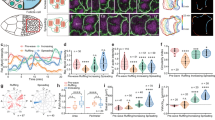Abstract
A surge in the secretion of gonadotropins stimulates several processes in mammalian preovulatory follicles, including oocyte maturation, cumulus expansion (mucification) and ovulation. This surge results in increased circulating levels of both luteinising hormome (LH) and follicle-stimulating hormone (FSH). It has generally been thought that LH is primarily responsible for the stimulation of the maturational processes in preovulatory follicles that results in ovulation and corpus luteum formation, and that FSH stimulates the development of the next wave of preovulatory follicles. A direct role for FSH in preovulatory events has been unclear. However, two studies have suggested that FSH is essential for certain preovulatory processes. First, there is evidence that the production of plasminogen activator by granulose cells is more sensitive to FSH than to LH1. Plasminogen activator could convert follicular fluid-borne plasminogen to plasmin, a protease capable of weakening the follicle wall2. Second, highly purified FSH, but not highly purified LH, stimulates cumulus expansion by isolated mouse oocyte–cumulus cell complexes3. A critical step in cumulus expansion is the deposition of a hyaluronic acid matrix, so that the synthesis of this glycosaminoglycan is very important in the preparation of the mouse oocyte–cumulus cell complex for normal ovulation. I report here that the synthesis of hyaluronic acid in vitro is stimulated by FSH but not by LH.
This is a preview of subscription content, access via your institution
Access options
Subscribe to this journal
Receive 51 print issues and online access
$199.00 per year
only $3.90 per issue
Buy this article
- Purchase on Springer Link
- Instant access to full article PDF
Prices may be subject to local taxes which are calculated during checkout
Similar content being viewed by others
References
Strickland, S. & Beers, W.H. J. biol. Chem. 251, 5694–5702 (1976).
Beers, W. H. Cell 6, 379–386 (1975).
Eppig, J. J. J. exp. Zool. 208, 111–120 (1979).
Rajaniemi, H. & Vanha-Perttula, T. Endocrinology 90, 1–9 (1972).
McNatty, D. P., Hunter, W. M., McNeilly, A. S. & Sawers, R. S. J. Endocr. 64, 555–571 (1975).
Whitten, W. K. Adv. Biosci. 6, 129–139 (1971).
Solursh, M. Devl Biol. 50, 525–530 (1976).
Ohya, T. & Kaneko, Y. Biochim. biophys. Acta 198, 607–609 (1970).
Author information
Authors and Affiliations
Rights and permissions
About this article
Cite this article
Eppig, J. FSH stimulates hyaluronic acid synthesis by oocyte–cumulus cell complexes from mouse preovulatory follicles. Nature 281, 483–484 (1979). https://doi.org/10.1038/281483a0
Received:
Accepted:
Issue Date:
DOI: https://doi.org/10.1038/281483a0
This article is cited by
-
Comparative effectiveness and safety of 36 therapies or interventions for pregnancy outcomes with recurrent implantation failure: a systematic review and network meta-analysis
Journal of Assisted Reproduction and Genetics (2023)
-
Oocyte competence is independent of the ovulation trigger adopted: a large observational study in a setting that entails vitrified-warmed single euploid blastocyst transfer
Journal of Assisted Reproduction and Genetics (2021)
-
GnRH triggering may improve euploidy and live birth rate in hyper-responders: a retrospective cohort study
Journal of Assisted Reproduction and Genetics (2020)
-
Dual trigger with gonadotropin releasing hormone agonist and human chorionic gonadotropin significantly improves live birth rate for women with diminished ovarian reserve
Reproductive Biology and Endocrinology (2019)
-
Evaluation of uterine receptivity after gonadotropin releasing hormone agonist administration as an oocyte maturation trigger: a rodent model
Scientific Reports (2019)
Comments
By submitting a comment you agree to abide by our Terms and Community Guidelines. If you find something abusive or that does not comply with our terms or guidelines please flag it as inappropriate.



